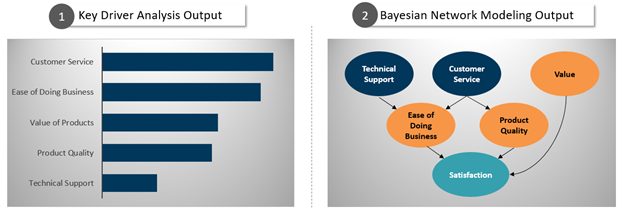The most essential (and most challenging) part of market research is uncovering the story that lives within the data. What is all of the data telling you about your customers and how your organization should act on the results?
Analytic tools and techniques are constantly evolving to help the underlying story come to life, and allowing researchers to deliver actionable insights that closely align with customer satisfaction, loyalty, or other key performance indicators. Key driver analysis and Bayesian networks are two examples of these powerful analytic tools that allow for a deeper understanding of what is driving your customers. Researchers need to continually ‘push the envelope’ to master these ever changing techniques. These techniques can even be taken a step further by developing new ways of combining the insights gained from each to reveal a stronger and more complete story for your organization.
KS&R’s Bayesian Network Predictive Driver Analytics (BNPDA) involves supplementing key driver analysis with additional information gained from Bayesian networks to uncover the relationships between the independent attributes (attributes such as customer services, ease of doing business, value, etc. that impact a target attribute like satisfaction). This method allows us to supplement the output derived from each method and uncover a deeper understanding of the relationships between attributes.
Below are two different output examples both related to a study aimed at understanding drivers of customer satisfaction.
Chart 1 shows a potential output for research involving key driver analysis. Based on these results, the main focus of resources should be on customer service and ease of doing business as they have the highest driver scores (and ultimately more impact on customer satisfaction).
While these alone are actionable results, uncovering associations among these attributes can shed light on the specific steps required to make an impact on customer perceptions. For example, ease of doing business is often a top attribute impacting customer satisfaction, but what does that mean and how does your organization improve it?
Chart 2 shows a fitted Bayesian network using the same data. The teal attribute is the dependent variable (satisfaction). The orange and blue independent attributes impact satisfaction.
Analyzing the results of these techniques together allows for a deeper understanding of the complete story, and sheds light on any small nuances. For example, chart 1 shows customer service is the top driver, but chart 2 shows that it does not directly impact satisfaction. While a focus on customer service will have the most impact on satisfaction, it will likely take time as customer service feeds into ease of doing business and product quality.
Combining techniques using our Bayesian Network Predictive Driver Analytics (BNPDA) also helps revel specific information about an attribute. For example, chart 1 shows ease of doing business is a top driver of satisfaction, but is a difficult attribute to allocate resources to due to its broad definition. Chart 2 tells us that in order to improve ease of doing business, a direct driver, the focus could be either customer service or technical support.
While both key driver analysis and the Bayesian network are extremely powerful analysis tools by themselves, combining them with our Bayesian Network Predictive Driver Analytics (BNPDA) will enable your organization to measure how much of an impact improvements will have. This in turn will help prioritize the actions you should take going forward to most efficiently achieve business objectives.



